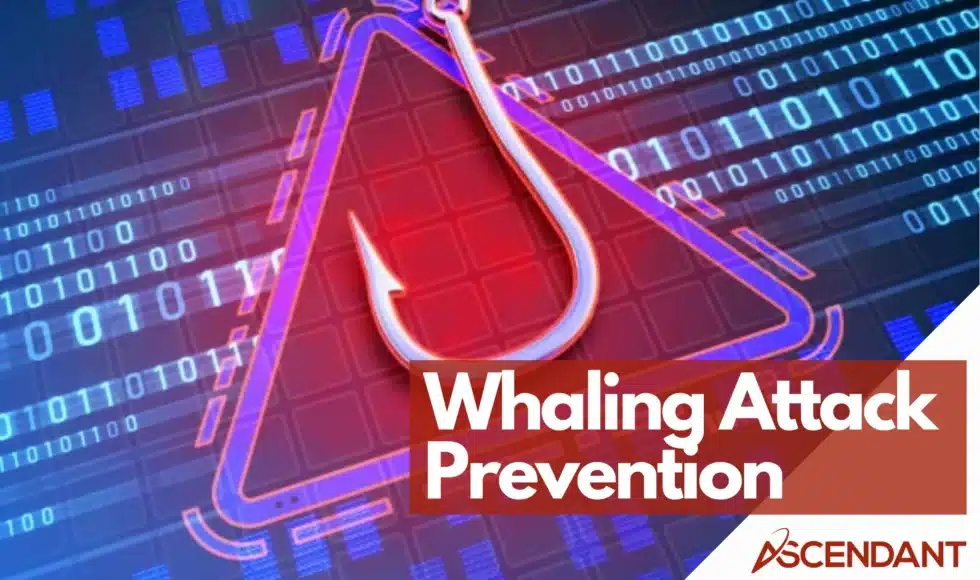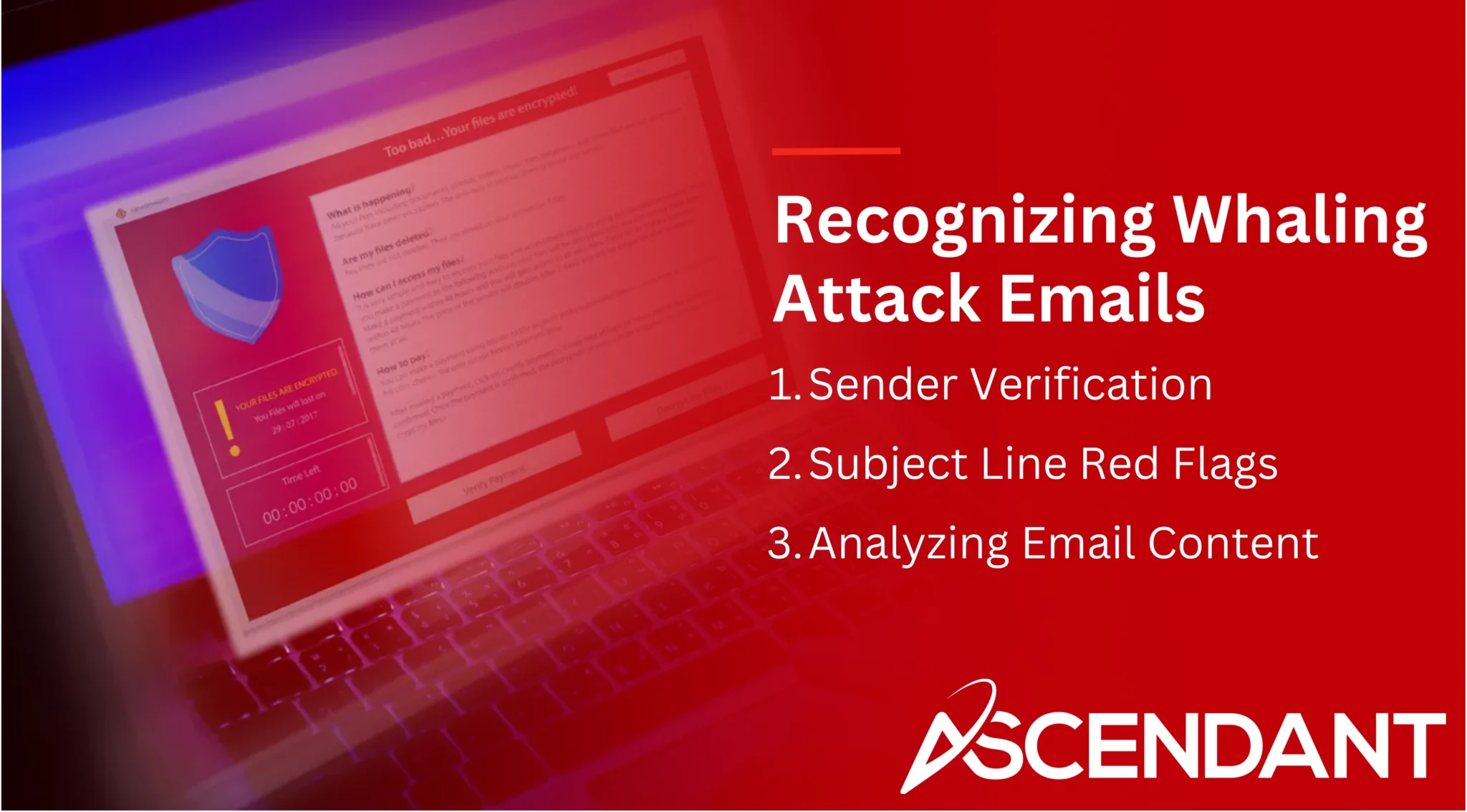A whaling attack targets senior executives using fake emails to steal sensitive information or funds. Understanding how these attacks work is key to preventing them.
Key Takeaways
- Whaling attacks specifically target high-profile individuals within organizations, employing sophisticated tactics and social engineering to manipulate victims into disclosing sensitive information.
- Preventing whaling attacks requires a comprehensive approach that includes employee training, multifactor authentication, advanced anti-phishing tools, and strong email security measures.
- Recognizing and responding to whaling attempts involves verifying sender authenticity, analyzing email content for red flags, and implementing immediate actions to mitigate damage after detection.
Understanding Whaling Attacks
Phishing attacks that fall under the category of whaling phishing specifically target high-ranking individuals such as executives, HR personnel, and IT staff. These forms of spear phishing are exceptionally targeted and challenging to identify, potentially leading to significant harm if they succeed due to their focus on influential figures.
Comprehending the distinctions between whale phishing attacks and other types of phishing efforts is key for enhancing preparedness and fortifying defenses against these advanced threats.
Definition of Whaling Attacks
A whaling phishing attack employs highly targeted spear phishing tactics to ensnare top-tier organizational members. Instead of casting a wide net, cyber attackers meticulously plan these intrusions to leverage the significant authority and access possessed by corporate executives, oftentimes posing as such individuals in efforts to coax employees into revealing sensitive information or executing unauthorized financial transactions.
Due to their direct line to confidential information and control over substantial financial assets and pivotal business choices, high-ranking officials are particularly attractive targets for malefactors seeking monetary enrichment or data pilfering – threats which pose considerable risks to an enterprise’s wellbeing.
Termed ‘wales’ within this context, these prominent figures symbolize lucrative opportunities for digital wrongdoers owing to the potentially hefty rewards that can be gleaned from successfully breaching the defenses surrounding them.
Whaling vs. Phishing vs. Spear Phishing
While standard phishing attacks cast a wide net, targeting many users with generic messages, whaling attacks are far more selective and sophisticated. Whaling focuses on high-ranking individuals, employing highly targeted and tailored tactics that make these attacks harder to detect.
Spear phishing, on the other hand, targets specific individuals but not necessarily high-profile ones, making whaling a more specialized subset of spear phishing and whaling. The sophisticated nature of whaling attacks often involves business email compromise (BEC) techniques, where attackers manipulate email addresses and domains to appear legitimate.
This makes verifying the sender’s email address a crucial step in preventing such attacks. Understanding these distinctions helps in developing tailored defenses against each type of phishing threat.
How Whaling Attacks Operate
Whaling attacks are sophisticated cyberattacks that employ advanced social engineering tactics, going beyond mere ingeniously crafted emails. Perpetrators conduct thorough research utilizing resources such as company websites and social media to compose personalized emails that effectively convince recipients to reveal sensitive information or carry out activities contrary to corporate guidelines. It is critical for organizations to comprehend the mechanics of how whaling attacks work in order to safeguard against them.
Social Engineering Techniques
At the core of whaling phishing attacks lies a reliance on social engineering tactics. These attackers frequently pose as familiar entities, like coworkers or professional associates, to lure victims into divulging sensitive data. By fostering a false sense of urgency and constructing convincing communications, they leverage personal details acquired from sources such as social media to enhance their facade.
These digital con artists excel at exploiting trust through deception. They craft counterfeit email addresses resembling those of trusted individuals and may even employ complimentary online platforms like Google Forms for gathering intelligence about their targets. Awareness of these deceptive techniques is crucial in arming oneself against these insidious forms of manipulation.
Crafting Convincing Whaling Emails
Creating a persuasive whaling email requires combining precise information about the intended victim with an element of immediateness. Perpetrators frequently employ tactics like social engineering, along with falsifying email appearances and contents, to give their messages an authentic look. These emails are intricately tailored and contain particular details pertaining to the enterprise’s internal activities that bolster their plausibility.
Perpetrators artfully alter email visuals and user addresses so they mimic legitimate sources, sometimes opting for domains nearly identical to those of well-known entities. They also incorporate personal information accessible from online profiles — including dates of birth and interests — adding another layer of seeming authenticity to these communications. Awareness and recognition of such strategies are crucial in thwarting successful whaling attacks.
Recognizing Whaling Attack Emails
To spot whaling attack emails, one must be alert and attentive to the finer points. Such emails may appear to originate from individuals you trust, engaging in extended correspondence that establishes a connection prior to making any fraudulent requests.
Being informed about methods like spoofing and various other tricks is beneficial for identifying possible attempts at whaling.
Sender Verification
Examining the sender’s email address carefully is an essential practice for identifying possible phishing dangers. During whaling attacks, perpetrators typically forge email addresses to masquerade as reputable figures. It’s imperative for executives to meticulously scrutinize the email domain and search for any inconsistencies in order to confirm that the sender is legitimate.
Persistent verification of email addresses plays a key role in diminishing the likelihood of being ensnared by intricate whaling attacks.
Subject Line Red Flags
In whaling attacks, scammers typically use subject lines that create a sense of urgency to compel recipients to act swiftly. They employ phrases such as “Immediate Action Required” or “Confidential Request” with the intent to alarm and deceive the targets into responding hastily.
Recognizing these warning signs is crucial for spotting dubious emails and thwarting impending whaling attacks.
Analyzing Email Content
Examining email content thoroughly is crucial for detecting possible whaling attacks. Whaling emails appear realistic because they include personal details and company-related specifics, lending authenticity to the message. Perpetrators of these schemes often gather information from social media platforms to tailor their communications, thereby increasing their chances of success.
It’s imperative to closely inspect any forms that ask for sensitive information as a safeguard against succumbing to such attacks. A meticulous review of an email’s request for sensitive data can assist in identifying and thwarting efforts at whaling.
Real-World Examples of Whaling Attacks
Examples of whaling attacks in the real world underscore the severe repercussions that such cyber threats can inflict, ranging from significant financial damages to compromising sensitive data.
The experiences gained from these instances offer critical insights into identifying and thwarting comparable future cyberattacks.
CEO Fraud at Crelan Bank
During an internal audit in 2016, Crelan Bank fell victim to a substantial whaling attack where fraudsters impersonated the CEO, leading to a financial setback of $75 million. This incident underscores the susceptibilities that financial institutions encounter and the intense economic and reputational harm inflicted by these types of security breaches.
Fake Zoom Invites at Tessian
Tessian fell victim to a whaling attack in 2020 when a co-founder mistakenly opened a malicious link disguised as a Zoom invite, leading to an $8.7 million loss. This attack demonstrates how cybercriminals exploit current trends and technologies to deceive targets and execute their schemes.
Gift Card Scams in Pune IT
In Pune, a whaling attack targeted IT sector employees with deceptive demands for gift cards. This type of scam takes advantage of workers and results in monetary damage while also eroding confidence inside the organization.
It is essential to tackle these strategies to avoid future occurrences that mirror this incident.
Strategies to Prevent Whaling Attacks
To substantially diminish the likelihood of an organization succumbing to sophisticated cyber threats, a comprehensive strategy must be employed. This strategy should encompass thorough training for employees, stringent email security measures, and the deployment of cutting-edge anti-phishing technologies specifically designed to counteract whaling attacks.
Employee Training and Awareness
It is essential to engage in continuous cybersecurity awareness training for employees to safeguard against sophisticated whaling attacks aimed at senior personnel. Programs dedicated to security awareness that evolve with changing methods and include hands-on components, such as mock phishing attacks, are vital in improving staff vigilance and understanding of the risks associated with whaling.
Implementing Multi-Factor Authentication (MFA)
By adopting multi-factor authentication (MFA), security is substantially improved through the use of multiple identity verification methods beyond mere passwords. This additional protective barrier increases the challenges for intruders attempting to access confidential accounts and data without authorization.
Utilizing Anti-Phishing Tools
Organizations are advised to employ advanced tools that use artificial intelligence for detecting phishing, aiming to thwart threats prior to reaching intended targets. To bolster defenses against whaling attacks and email spoofing, it’s imperative that organizations implement robust anti-spam and antivirus programs. Adopting email verification protocols like SPF, DKIM, and DMARC, which significantly improve security measures.
Enhancing Email Security
It is essential to enhance email security measures to thwart whaling phishing attacks effectively. By implementing solid email security systems and establishing explicit protocols for managing data, one can protect against contemporary whaling phishing threats and secure the confidentiality of sensitive information.
Advanced Email Security Solutions
To ensure robust protection against whaling attacks, top-tier email security systems need to extend their coverage over all electronic communications. Such defenses are tasked with identifying and mitigating potential dangers before they cause damage, employing Advanced Malware Protection (AMP) mechanisms for detecting, obstructing, and eliminating malicious software.
Regular Security Audits
Regularly performing security audits is crucial for pinpointing weaknesses and bolstering the defenses within email security systems. Such reviews are key to identifying potential vulnerabilities, thereby strengthening the protocols in place for email security.
Scrutinizing emails and attachments that originate from external sources for signs of malware or viruses is instrumental in averting potential breaches in security.
Reporting and Responding to Whaling Attacks
It’s imperative to act swiftly and decisively when faced with whaling attacks to reduce their detrimental effects. Prompt measures and established reporting protocols are key in preventing whaling attacks, confining any security breaches, and promoting detailed examinations of the incident. Being well-informed about the appropriate actions can greatly influence the results following such an attack.
Immediate Actions
In the event of a whaling attack, it’s crucial to isolate the impacted machine from the network immediately to halt any dissemination of malware. It is also imperative to change login credentials promptly in order to deny attackers entry into accounts that have been breached.
It is vital to alert both the cybersecurity or IT department and pertinent financial personnel as soon as possible so they can begin their respective protocols for handling such an incident.
Reporting Procedures
It is crucial to report a whaling attack promptly to local law enforcement authorities, as well as to contact national cybercrime divisions regarding the incident. Recording every detail of the event, such as specific timelines and actions taken in response, supports investigative efforts and contributes to thwarting potential future attacks.
 Summary
Summary
Organizations are at substantial risk from whaling phishing attacks, as these cyber threats are designed to deceive high-profile individuals who have access to confidential information. To effectively counteract whaling attacks, it is crucial for entities to grasp how they operate, identify the warning signs, and adopt strong defensive techniques. Strengthening email security protocols and providing continual education can markedly diminish the likelihood of falling prey to these advanced forms of phishing attacks. Maintaining alertness and taking preventive actions remain vital in protecting an organization from the adverse consequences associated with whaling phishing incidents.
Frequently Asked Questions
What is a whaling phishing attack?
A whaling phishing attack is a targeted cyberattack that specifically targets high-profile individuals, such as executives, through personalized and sophisticated deception methods.
It is crucial to be vigilant against such threats to protect sensitive information.
How can I recognize a whaling attack email?
To recognize a whaling attack email, watch for spoofed email addresses, urgent subject lines, and personalized requests for sensitive information.
Always verify the sender’s identity before taking any action.
What immediate actions should I take if I suspect a whaling attack?
If you suspect a whaling attack, immediately disconnect the affected computer from the network, change your login credentials, and notify your cybersecurity or IT team along with the relevant financial department.
Taking these actions immediately is crucial to mitigate potential damage.
How can I prevent whaling attacks in my organization?
To effectively prevent whaling attacks in your organization, implement employee training programs, utilize multi-factor authentication, and deploy advanced anti-phishing tools alongside robust email security protocols.
Ensuring these measures are in place is crucial for safeguarding sensitive information.
Why are executives targeted in whaling attacks?
Executives are targeted in whaling attacks due to their access to sensitive information and financial resources, which can yield significant payoffs for attackers.
Their high-profile status also increases the likelihood of a successful breach.


